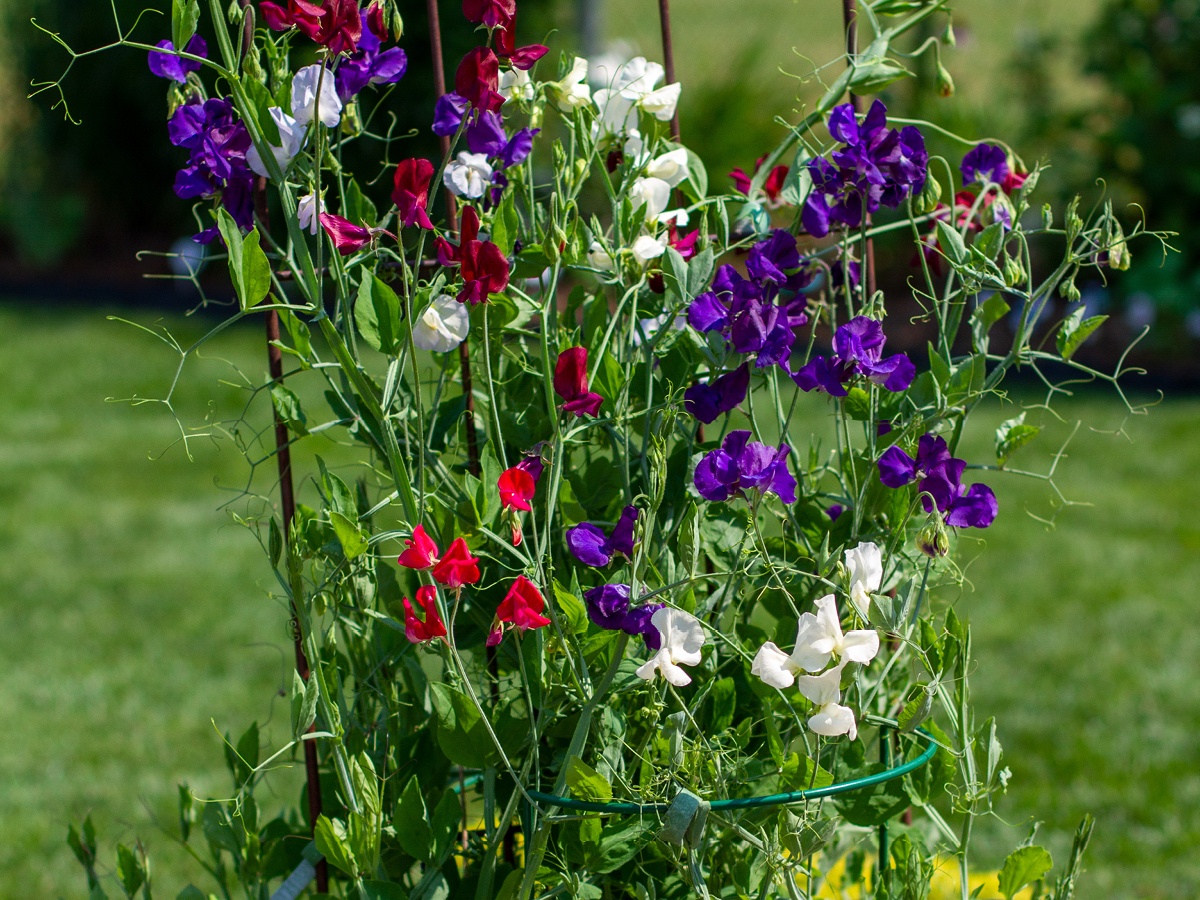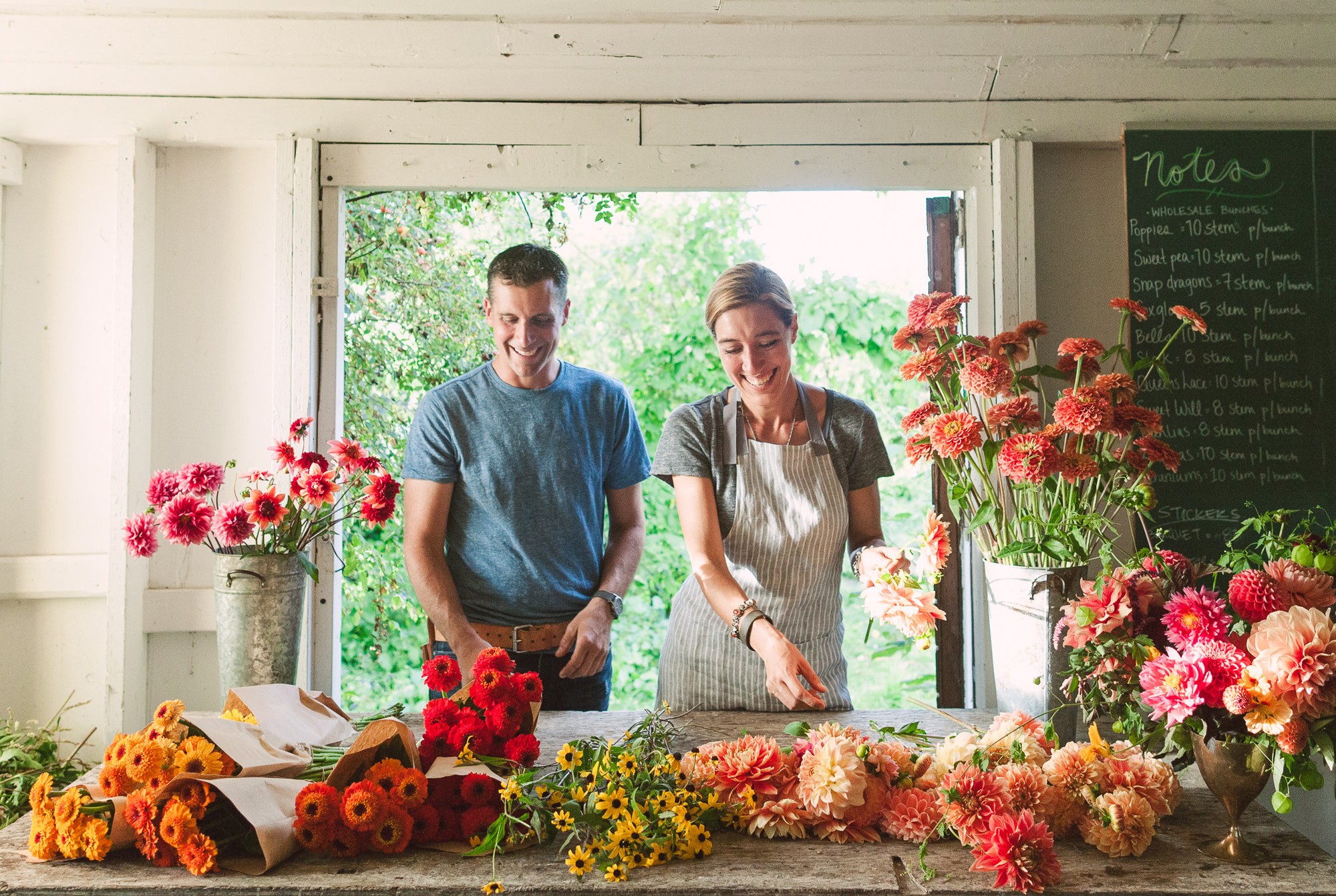1. In warmer regions where winter weather is mild, sow sweet peas in autumn. Everywhere else, sow in late winter/early spring. Soak your seeds for 24 hours before sowing. This softens the seed coat and speeds the sprouting process by a few days.
2. While the seeds are soaking, fill your planting pots with soil. Sweet peas produce a ton of roots even in the beginning, so the more room you can give them during the early stages of life, the better they will grow in the long run. I use pots that are 3½ in (9 cm) wide and deep.
3. Plant two seeds per pot, poking them ½ in (1.25 cm) into the soil with your finger.
4. Cover pots with a plastic dome lid to increase humidity and speed up germination. Place in a cool greenhouse or in a bright window in the house.
5. Once plants are 4 to 6 in (10 to 15 cm) tall, pinch out the central growing tip, just above a leaf joint, leaving just 2 or 3 leaf nodes. This will encourage the plant to branch vigorously from the base.
6. Sweet peas are heavy feeders. So, in addition to the standard soil preparation, I run a trench 1 ft (30 cm) deep down the center of the bed and fill it with compost or well-rotted manure, so that once the sweet peas send their roots down deep, there is a feast awaiting them.
7. Vines grow rapidly and require a spot that gets full sun, as well as a strong structure to climb. Place tall posts roughly 8 ft (2.4 m) apart down the row and attach either Tenax Hortonova netting or 6-ft-high (1.8 m) metal fencing for them to scramble up.
8. Around the last spring frost, plant out seedlings in 2 rows, one on each side of the trellis, roughly 8 in (20 cm) apart down the row. Keep them tied to the trellis to produce straight stems. Once the vines get going, you can expect over 1 ft (30 cm) of growth a week, so be sure to stay on top of tying.
9. Sweet peas love water, and without consistent moisture, they won’t thrive. Keeping their thirst quenched during warm weather is crucial, so set up drip irrigation or soaker hoses as soon as you plant them. We water deeply 2 to 3 times a week.
10. To prolong blooming, it’s important that you keep plants from setting seed, so be sure to harvest and deadhead the flowers frequently. For the longest vase life, pick stems that have at least 2 unopened flowers at the tip. While they can be picked when more open, their vase life won’t be as long. Sweet peas are a short-lived cut flower, lasting at best 4 to 5 days in a vase. Adding sugar or flower preservative to the water makes a big difference and will add a few extra days.
Are you dreaming of those gorgeous, fragrant sweet pea flowers but don’t have a garden? Don’t worry! I’ve been growing sweet peas in containers for years, and I’m excited to share everything I’ve learned about creating a stunning display of these beautiful climbers in pots.
Why Grow Sweet Peas in Containers?
Sweet peas are amazing container plants because
- They produce masses of colorful, fragrant blooms
- Perfect for balconies, patios, and small spaces
- Can be moved around to follow the sun
- Easier to protect from pests and weather
- Great for renters or those without garden space
Essential Container Requirements
Container Size and Type
- Use large containers at least:
- 20 inches wide
- 16 inches deep
- 1.5 cubic feet capacity
- Choose plastic containers for hot climates
- Avoid terracotta pots (they dry out too quickly)
Potting Mix
For best results
- Use high-quality potting mix
- Never use garden soil
- Add well-rotted manure
- Include compost if available
Support Structures
Sweet peas need something sturdy to climb on:
- 6-foot bamboo canes arranged in a teepee
- Secure canes firmly at the top
- Use chicken wire or soft netting
- Avoid thick metal trellises or lattices
Planting Your Sweet Peas
When to Plant
Timing depends on your climate
- Autumn planting (warm climates)
- Late winter/early spring (cool climates)
- Plant out when roots fill seedling pots
How to Plant
- Space 6 seedling pots evenly around support
- Plant 2-3 plants per group
- Don’t plant seeds directly in containers
- Water well after planting
Care and Maintenance
Watering Tips
- Never let soil completely dry out
- Check moisture level daily
- Water when top 1-2 inches feels dry
- Mulch to retain moisture
Feeding Schedule
- Use organic fertilizer like fish emulsion
- Feed every 2-3 weeks during flowering
- Add compost tea occasionally
- Stop feeding when plants decline
Training and Pruning
- Tie stems to supports weekly
- Remove tendrils (they’re not needed)
- Pinch tips when plants reach 15cm
- Cut flowers regularly for more blooms
Common Problems and Solutions
Pest Control
- Watch for birds attacking seedlings
- Use netting for protection
- Monitor for thrips
- Check for powdery mildew
Temperature Issues
- Protect from extreme heat
- Shade roots in hot weather
- Move containers if needed
- Expect decline above 90°F
Tips for Success
- Choose scented varieties
- Plant in succession for longer blooming
- Pick flowers every 9-10 days
- Keep roots cool and heads in sun
- Provide wind protection
My Personal Experience
I’ve been growing sweet peas in containers for 5 years now, and let me tell ya, they can be a bit tricky at first! Last year, I totally messed up by using pots that were way too small – my poor sweet peas looked so sad! But now I’ve got it figured out, and my balcony looks absolutely gorgeous every spring.
Growing sweet peas in containers isn’t rocket science, but it does need some attention to detail. With the right size pot, good support, and regular care, you’ll have a stunning display of fragrant blooms that’ll make your neighbors jealous!
Quick Checklist for Success
- Large container with drainage
- Quality potting mix
- Strong support structure
- Regular watering
- Consistent feeding
- Frequent harvesting
- Protection from extreme weather
Remember, sweet peas aren’t just pretty – they’re like having your own perfume factory on your patio! Just keep in mind that while they’re gorgeous to look at, they’re NOT edible and are actually toxic if eaten.
Got questions about growing sweet peas in containers? Drop them in the comments below – I’d love to help you get started on your sweet pea journey!

Join Us Join the Floret newsletter & stay in the loop on all the exciting happenings here on the farm
When you join our newsletter, you’ll receive helpful flower-growing tips, special offers, advance notice about upcoming workshops, exciting announcements, and all the behind-the-scenes news from Floret. Search Floret Flowers
- Search Shop
- Search Rest of Site
What You Will Need
- Top-quality sweet pea seed
- Seed-starting mix
- Compost
- Fertilizer
- Tall posts
- Tenax Hortonova netting or 6-ft-high metal fencing
- In warmer regions where winter weather is mild, sow sweet peas in autumn. Everywhere else, sow in late winter/early spring. Soak your seeds for 24 hours before sowing. This softens the seed coat and speeds the sprouting process by a few days.
- While the seeds are soaking, fill your planting pots with soil. Sweet peas produce a ton of roots even in the beginning, so the more room you can give them during the early stages of life, the better they will grow in the long run. I use pots that are 3½ in (9 cm) wide and deep.
- Plant two seeds per pot, poking them ½ in (1.25 cm) into the soil with your finger.
- Cover pots with a plastic dome lid to increase humidity and speed up germination. Place in a cool greenhouse or in a bright window in the house.
- Once plants are 4 to 6 in (10 to 15 cm) tall, pinch out the central growing tip, just above a leaf joint, leaving just 2 or 3 leaf nodes. This will encourage the plant to branch vigorously from the base.
- Sweet peas are heavy feeders. So, in addition to the standard soil preparation, I run a trench 1 ft (30 cm) deep down the center of the bed and fill it with compost or well-rotted manure, so that once the sweet peas send their roots down deep, there is a feast awaiting them.
- Vines grow rapidly and require a spot that gets full sun, as well as a strong structure to climb. Place tall posts roughly 8 ft (2.4 m) apart down the row and attach either Tenax Hortonova netting or 6-ft-high (1.8 m) metal fencing for them to scramble up.
- Around the last spring frost, plant out seedlings in 2 rows, one on each side of the trellis, roughly 8 in (20 cm) apart down the row. Keep them tied to the trellis to produce straight stems. Once the vines get going, you can expect over 1 ft (30 cm) of growth a week, so be sure to stay on top of tying.
- Sweet peas love water, and without consistent moisture, they won’t thrive. Keeping their thirst quenched during warm weather is crucial, so set up drip irrigation or soaker hoses as soon as you plant them. We water deeply 2 to 3 times a week.
- To prolong blooming, it’s important that you keep plants from setting seed, so be sure to harvest and deadhead the flowers frequently. For the longest vase life, pick stems that have at least 2 unopened flowers at the tip. While they can be picked when more open, their vase life won’t be as long. Sweet peas are a short-lived cut flower, lasting at best 4 to 5 days in a vase. Adding sugar or flower preservative to the water makes a big difference and will add a few extra days.

Here’s how you can grow sweet peas in pots and create whimsical trellises for your cottage garden!
0
